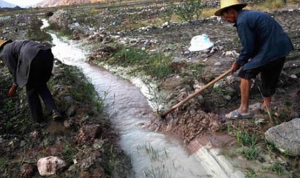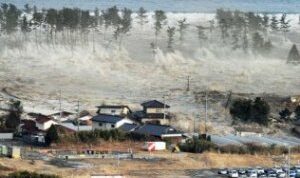 Japanese military helicopters are dumping water onto the stricken Fukushima nuclear power plant, 250 kilometres north-east of Tokyo, in a bid to douse fuel rods and prevent a disastrous radiation release.
Japanese military helicopters are dumping water onto the stricken Fukushima nuclear power plant, 250 kilometres north-east of Tokyo, in a bid to douse fuel rods and prevent a disastrous radiation release.
Four twin-rotor CH-47 Chinooks of the Japan Self-Defence Forces ran the first mission to empty tonnes of water onto the facility damaged by last Friday’s massive earthquake and tsunami, which have already claimed the lives of more than 5,000 people.
The operation aims to keep the fuel rods inside reactors and containment pools submerged under water to prevent any more radiation from leaking.
The helicopter mission started this morning under a clear sky after a similar effort yesterday was called off shortly before darkness fell by officials citing strong radiation and high winds.
A fleet of firetrucks and police water cannon are moving in to spray the reactors from the ground.
Defence minister Toshimi Kitazawa said an additional 11 military vehicles would be deployed for efforts to help cool the reactors, while pumps supplied by the US armed forces were also being transferred.
The Japanese government does not yet know if the operation has succeeded.
Tokyo has denied claims that the spent fuel rods in the No. 4 reactor are totally exposed, with cabinet spokesman Yukio Edano says there’s still water inside.
The plant’s operators are desperately trying to restore electricity supply so the cooling system can restart
Australians have been told to leave the capital and other areas affected by the ongoing crisis.
The Department of Foreign Affairs has now widened its recommended exclusion zone for Australians around the Fukushima plant to 80 kilometres.
Japanese authorities had ordered people within 30 kilometres of the plant to evacuate or stay indoors.
This afternoon the Federal Government said the number of Australians unaccounted for in Japan had fallen to 21.
‘Top priority’
The Japanese government’s nuclear safety agency has said the top priority should be pouring water into the fuel-rod pools at reactors three and four, which may be boiling and are not fully covered by roofs that would reduce radiation leaks.
An official at plant operator Tokyo Electric Power Co (TEPCO) says the pool at the No. 4 reactor “seemed to have water” on Wednesday, based on aerial observation carried out by the military helicopters.
Another TEPCO spokesman said: “We have not confirmed how much water was left inside but we have not had information that spent fuel rods are exposed”.
TEPCO said earlier it was concentrating on restoring the power supply to reactivate its crippled cooling systems, which were knocked out in the dual calamity that hit Japan.
“We cannot tell when, but we want to restore the power source as soon as possible,” TEPCO spokesman Naohiro Omura told AFP.
Employees of TEPCO and other industry firms have volunteered to join efforts to control the escalating crisis, local media said.
TEPCO put out a call for about 20 volunteers to join the battle to bring the situation under control at the Fukushima No.1 plant, where last week’s quake and tsunami knocked out the reactor cooling systems, Jiji Press reported.
Offers came in from TEPCO employees and others, including a 59-year-old man with four decades of experience working at nuclear power stations for a regional power company and was due to retire in six months, the report said.
Officials at TEPCO were not immediately available to confirm the reports.
TEPCO was preparing to restore outside power lines from Tohoku Electric Power Co., which serves the region, and connect its damaged electric transmission system with unaffected lines.
“At the moment, we are concentrating our efforts on this work,” he said.
“If the restoration work is completed, we will be able to activate various electric pumps and pour water into reactors and pools for spent nuclear fuel.”
The 9.0-magnitude quake, the biggest on record to strike Japan, knocked down electricity pylons which Tohoku had used to supply power to the TEPCO plant.
Some 70 workers have been using pumps to pour seawater to cool reactors at the plant, according to media reports, using electricity from borrowed mobile generators.




